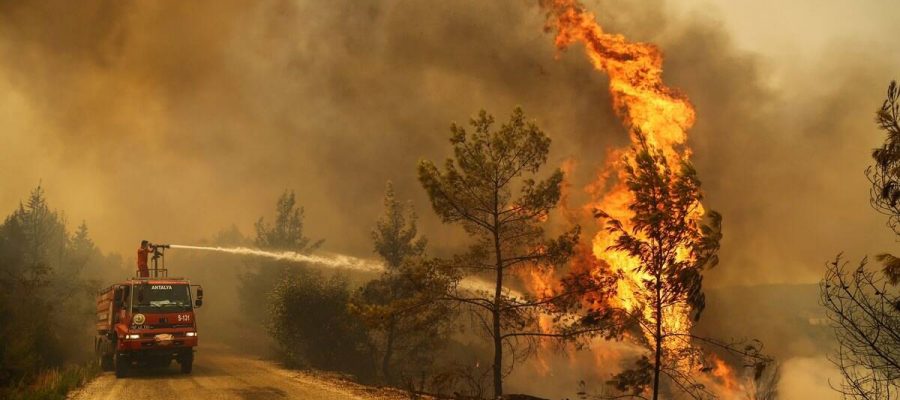The report says that there was now “unequivocal” evidence to say that global warming was being caused by human activities.
Get email alerts for your favourite author. Sign up here
In another grim reminder of the threat posed by global warming, the Inter-governmental Panel on Climate Change (IPCC) on Monday warned that the average global temperatures would rise by more than two degree Celsius by 2100 compared to pre-industrial times unless “deep reductions” in greenhouse gas emissions are initiated immediately.
The IPCC released the first part of its Sixth Assessment Report (AR6), its latest evaluation of the state of earth’s climate, the changes happening therein, and the impacts these are having on the planet, and life forms. The voluminous assessment reports are the most widely-accepted scientific opinion on the status of earth’s climate.
The first part of AR6, which presents scientific evidence for climate change, says that global temperatures had already risen by about 1.1 degree Celsius from pre-industrial times, a reference to the period between 1850 and 1900, and warns that a 1.5 degree Celsius warming was likely to be achieved before 2040.
The stated objective of the 2015 Paris Agreement, the international architecture to fight climate change, is to limit temperature increase to within 2 degree Celsius from pre-industrial times, hopefully within 1.5 degrees Celsius itself. Scientists say a temperature rise beyond 2 degree Celsius would result in catastrophic and irreversible changes that would make it difficult for human beings and other species to survive.
The sixth assessment report says that even if very wide-ranging and ambitious cuts in greenhouse gas emissions are initiated immediately, the temperature rise was expected to cross 1.5 degree Celsius, and reach 1.6 degree Celsius, before being reined back to 1.5 degrees Celsius.
Limiting the temperature rise to 1.5 degree Celsius, or even 2 degree Celsius, would be “beyond reach”, unless “immediate, rapid and large-scale” reductions in greenhouse gas emissions takes place, the report says.
The report says that there was now “unequivocal” evidence to say that global warming was being caused by human activities. It says “multiple lines of evidence” now supports this.
The IPCC, which was set up in 1988 by the World Meteorological Organisation (WMO) and UN Environment Programme (UNEP), does not produce any new science itself. Instead, it assembles scientists from all over the world to review all the relevant scientific literature on climate change, and arrive at general conclusions about the trends being observed.
The AR6 says that observed changes in earth’s climate, induced by global warming were unprecedented in thousands, and in some cases hundreds of thousands of years. Some of these changes, like sea-level rise, or glacier melt, would remain irreversible over hundreds of thousands of years. Sea-levels had already risen by about 20 cm, on an average, in the last 100 years, and are likely to rise further by 30 cm to one metre, depending on future emissions.
The rising temperatures were expected to result in longer, more intense, and more frequent extreme events. Heat waves as heavy rainfall events were likely to increase.
“We have the clearest picture of how the earth’s climate functions, and how human activities affect it. We know, better than ever, how the climate has changed in the past, how it is changing now, and how it will change in the future,” Valerie Masson-Delmotte, co-chair of the working group-I, which has produced this first part of AR6, said at a press conference.
“In the next 20 years, global warming is expected to reach or exceed 1.5 degree Celsius above the 1800s. However, if we rapidly reduce greenhouse gas emissions, if we can reach global net zero CO2 emissions around 2050, it is extremely likely that we can keep global warming well below 2 degrees. If we do this, it is more likely than not that temperature would gradually decline to below or around 1.5 degree Celsius by the end of this century, with a temporary overshoot of not more than 0.1 degree Celsius,” she said.
“But if global greenhouse gas emissions remain around today’s levels in the coming decades, we would reach 2 degrees of global warming by the middle of this century,” Masson-Delmotte said.
“With every additional amount of global warming, we will see greater changes in the climate. Every additional half degree of warming will cause increase in the intensity and frequency of hot extremes, heavy precipitation and drought. At 2 degrees of global warming, heat extremes would more often reach critical tolerance thresholds for agriculture and human health. At a global scale, extreme daily rainfall events would intensify by about 7 per cent for each additional degree Celsisus of global warming,” she said.
Source: Read Full Article



